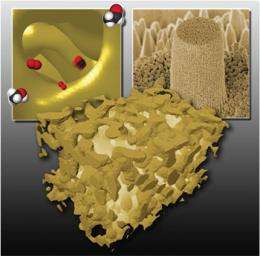Gold hits its golden age as a high-tech material

Gold isn't just for wedding bands anymore.
Despite its reputation as an inert material, nanostructured gold is a very promising candidate as a catalyst, optic, sensor, energy harvester as well as an energy storer.
The Laboratory's Juergen Biener and Arne Wittstock and colleagues have explored the field by editing a Royal Society of Chemistry book "Nanoporous Gold: From an Ancient Technology to High-Tech Material."
Humans have regarded gold for its color, stability and most importantly its value. But by bringing it into a nanoporous form, its characteristics change. For example, instead of gold's yellow color it appears coppery, it is getting mechanically stronger, it may change its macroscopic dimensions depending on its surrounding gas atmosphere, and catalyze chemical reactions already at room temperature.
The combination of a pure bulk gold material in conjunction with its nanostructure results in many impressive properties and a variety of possible technical applications. It is one of the best examples of a material that changes characteristics when going from macro to nanosize. Because of the value of gold as a precious metal and its chemical inertness, it can be a very green and sustainable material-resource and non-toxic for humans and the environment. In fact, in the USA in 2010 more gold was actually recycled from scrap than used.
Gold, indeed, represents an especially suited material for various technological applications, according to Wittstock and Biener.
The new book provides a broad and multidisciplinary platform to discuss and learn more about the properties of nanoporous gold as the prime example of corrosion derived bulk nanostructured materials from a multidisciplinary perspective. The book covers different aspects of the material, starting from generation of its nanostructure by corrosion on a theoretical as well as experimental level, covering its mechanical properties and techniques to prepare different designs of the material, all the way to its application in technological sectors such as in optics, electro catalysis, actuation, catalysis and sensors.
The idea behind the book is to provide a broad and up-to-date platform of an understanding of this type of nanomaterial for a broad readership. This book is not solely addressing specialists of a particular academic field but rather a readership ranging from graduate students to professional researchers in academia and industry.
Provided by Lawrence Livermore National Laboratory



















